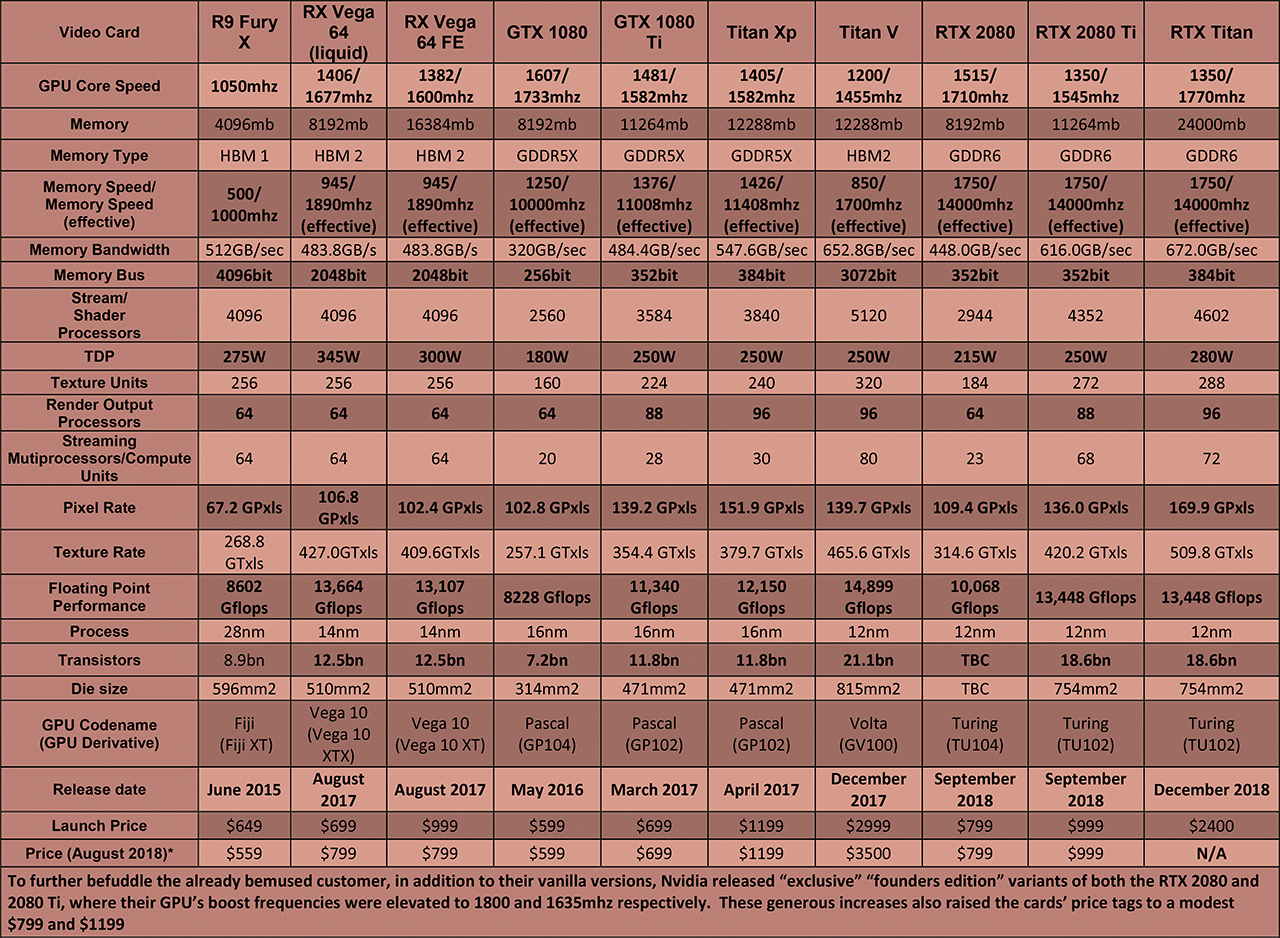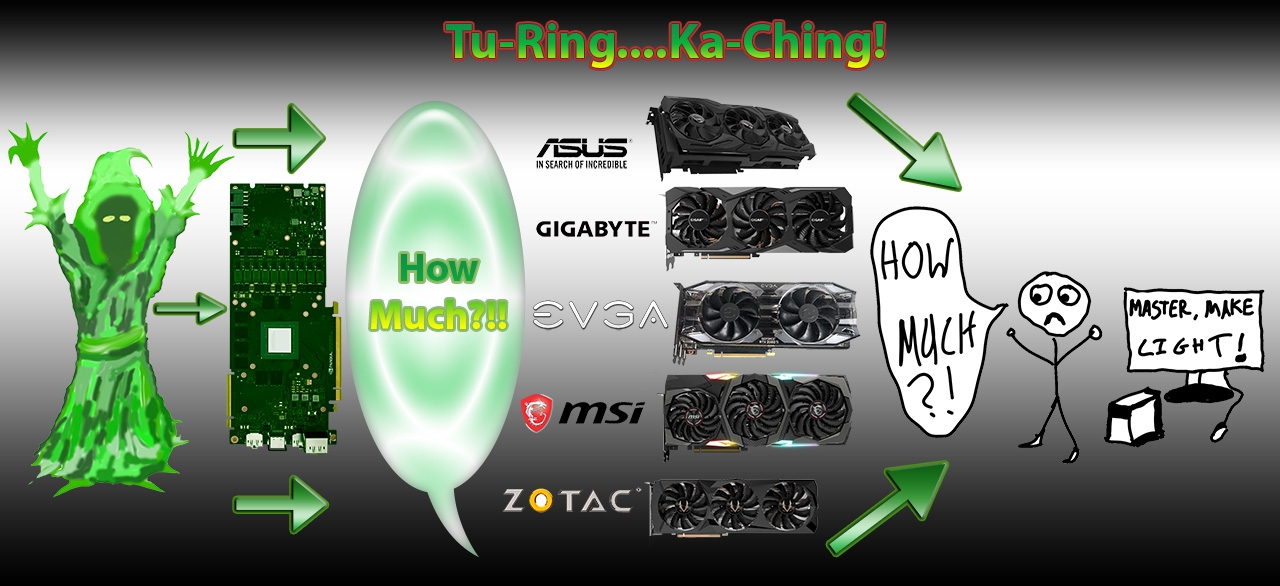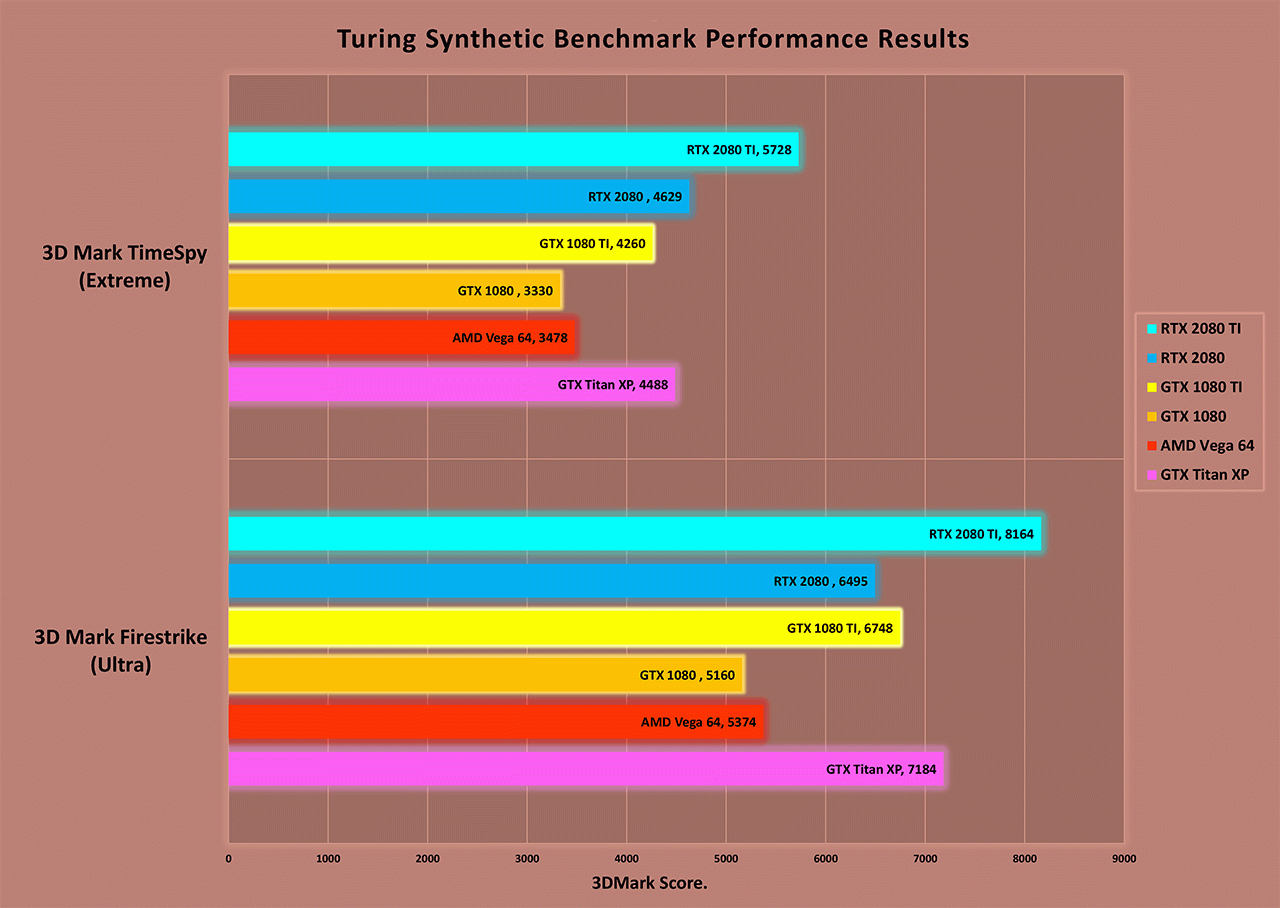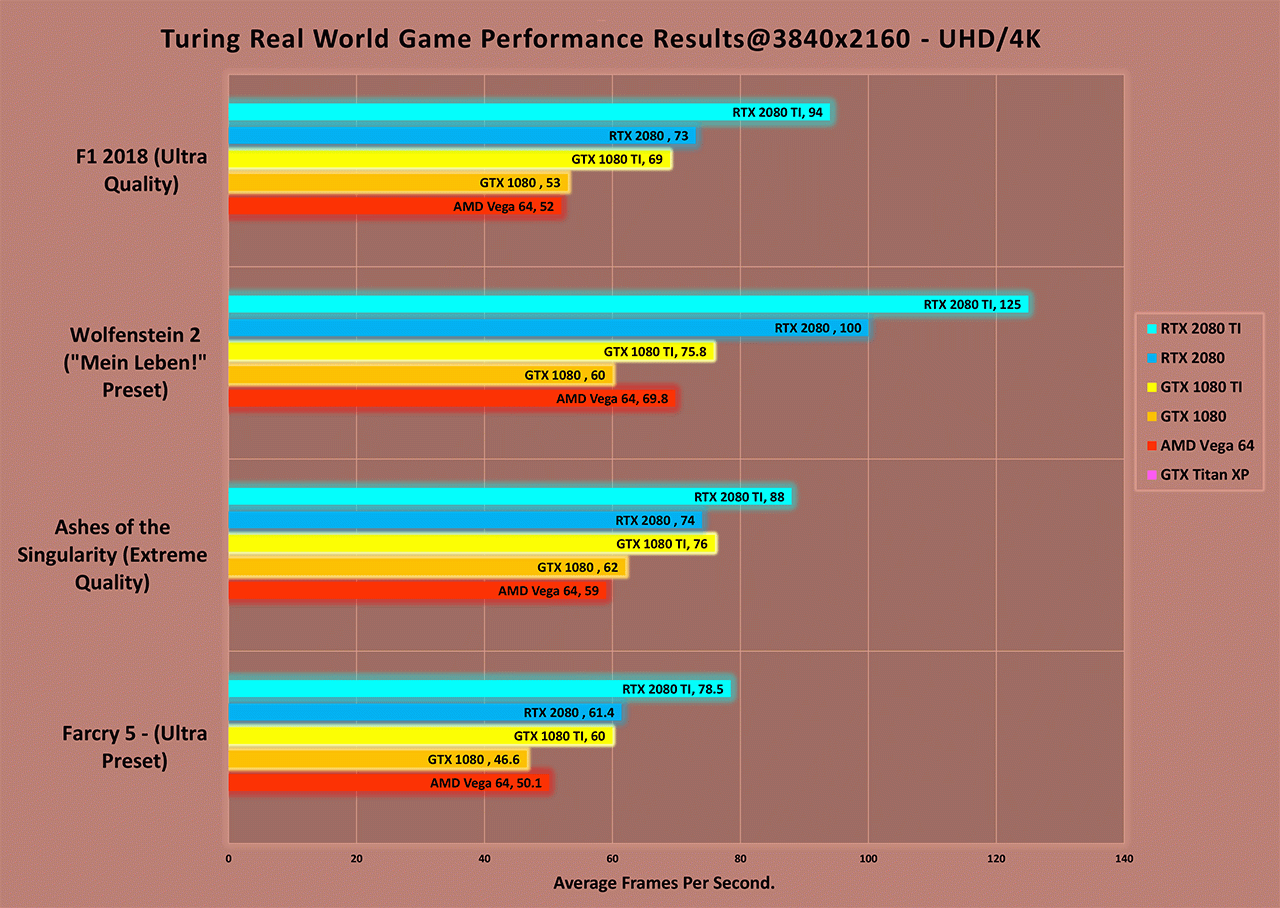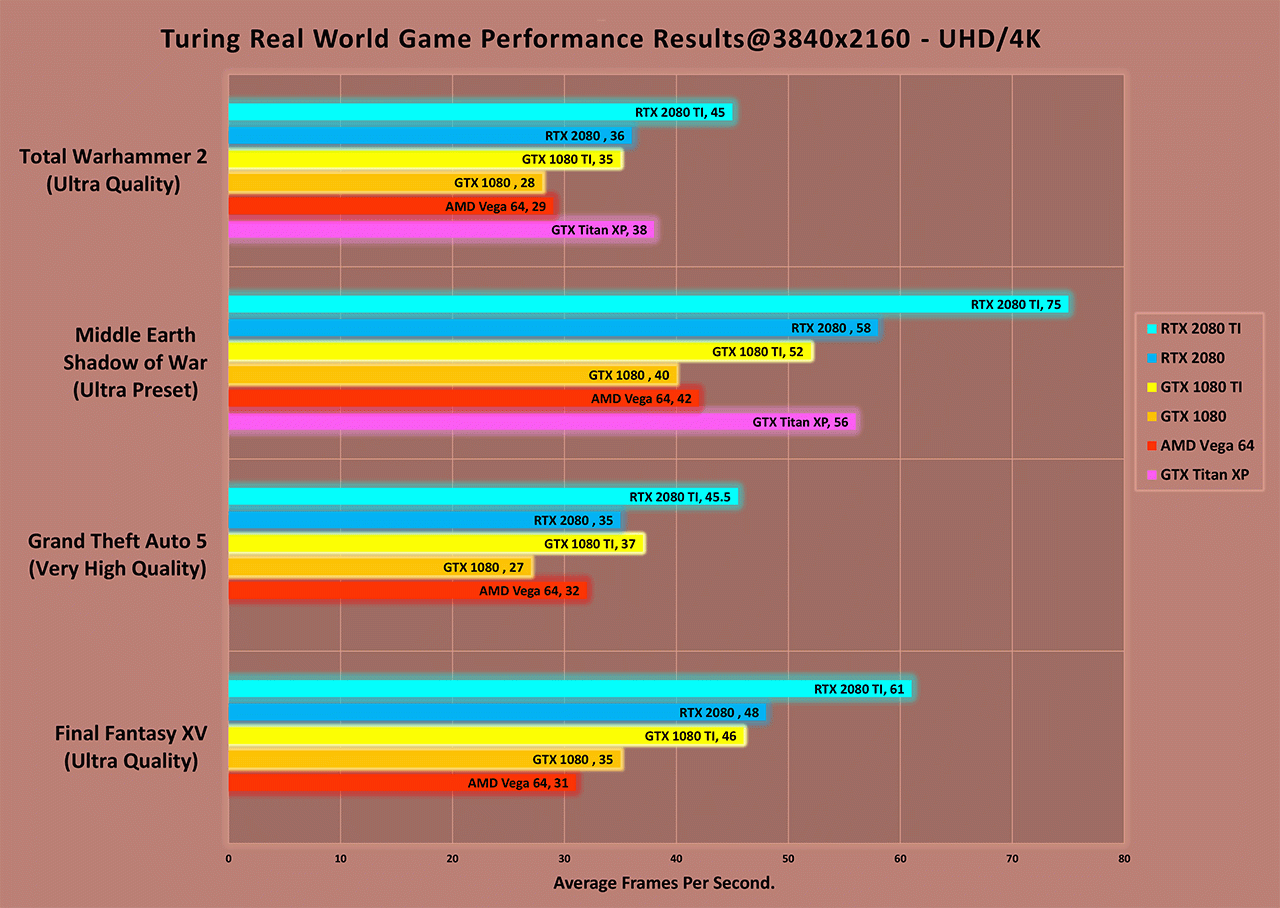Turing the Scenery!
A cryptic pun alluding to a renowned English scientist and a rewarding means by which to frequent and assimilate one’s surroundings. What better way to welcome technology conceived to conjure luminous dawns across emerald seas, glowing sunsets over ruby cities or pearl peppered mountains stretching into star spangled skies, and all without the hassle of hauling around the three cameras you insisted were necessary to capture such natural phenomena, quite apart from the additional burdens of passports, check-ins, luggage, cramped seating, hotels that look luxurious on the website but in reality suffer from mould, dirty linen, rancid cuisine and radioactive swimming pools.
I am of course referring to yet another of Giant Green Eye’s spectacular innovations. Fortuitous it was too, for up until mere months before Nvidia’s then CEO, Jensen Huang strode out to preach his sleight of tongue sermon, nearly all reputable sources has suggested that Team Verdant’s “Volta” would be the fabrication empowering their imminent brotherhood of “visionary” virtuosi.
Volta had debuted six months earlier, within one of Nvidia’s recurring manifestations marketed at profligate pro-sumers , Titan V. The fifth wallet withering thoroughbred of “Titanic” pedigree but the first to incorporate a feature pivotal to the functionality of its indirect descendant, Tensor Cores. As if Cuda Cores, ROPs, Texture Units and Streaming Mult-is had not crowded their “communal clusters” to capacity, now, a second hard-core battalion had burrowed its way into the die, eager to animate and illuminate in alluring harmony alongside their devoted artisans.
This, or course, is merely a flowery way of interpreting “parallel processing”, the architectural concept that Nvidia had relied upon and dramatically evolved for more than two preceding decades, during which diagrams such as the one below became intolerably pervasive and bemusing.
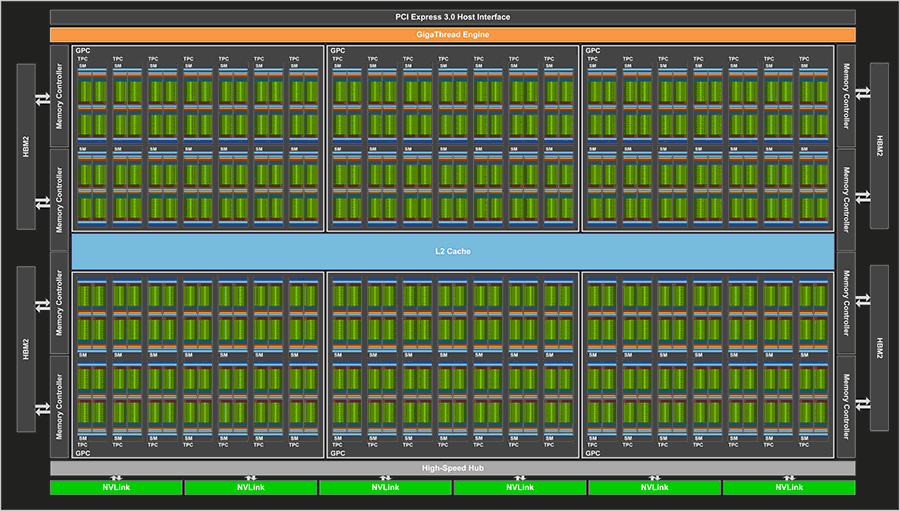
Please do not give yourself a throbbing head by attempting to decipher it. All shall be clarified by a fact packed table in a paragraph or two
Chronic Pixel addicts had presumed that the Titan V would promptly spawn less extravagant siblings and hence, permit Volta to wholly supplant its 16 nano-meter predecessor, Pascal, which had been serving up succulent eye-candy since the Summer of 2016. However, our Mean Green Giant was in no rush, for a certain Ruby rival had fallen a few frames short in the last blitz of benchmarks. AMD had elected to forgo a bid for textural tyranny against clan Pascal, largely due to their concerted quest for renewed reverence in the market that had generated their initial success, the one long dominated by the barbarous Baron Von Intel, and while fanboys grumbled over the Crimson Crew’s single year sabbatical, their strategy against two companies whose collective assets were almost forty times greater no doubt required diligent and extensive planning.
Their “visual” counter punch eventually manifested as the “Vega” family, a trio of cards which rolled into retail during August 2017 and were supposed to render Pascal into a permanently passive state. Despite over two years of development and considerable hype, it rapidly became evident that neither the hardware nor its drivers were potent or polished enough to mount a successful challenge and unless crypto currency was of paramount importance, these crimson pretenders not only failed to displace their emerald counterparts by a notable margin, they did so with a comparatively bloated carbon footprint.
Aside from leaving many of AMD’s most ardent activists a tad redder around the cheeks and rosier in the eye, this dismal lack of competition gave Nvidia “card blanche” to languish on their laurels for another long year, and as Spring yielded to Summer in 2018, The Turing demonstrated how commercial corporations with veritable monopolies can afford to hike prices, dazzle with jargon and transform candid product launches into cagey campaigns conducted to stimulate exponential speculation. As Turing’s titillating specifics tricked into the public domain, legions of aspiring “influencers” leapt onto the “brand wagon” to see who could regurgitate and elaborate for the longest and loudest and by convenient default, ease the considerable burden on Nvidia’s internal promotions division.
So what had provoked such intense and extrovert anticipation, and what was the essence of Mr. Huang two hour preaching? The answer lay in the product’s subtly revised prefix “RTX”.
For more than two decades hitherto, the Geforce moniker had been associated with the monogram “GTX” and it wasn’t until I ventured to stir up misty jade-coloured memories that I discovered these letters bore no significance other than to denote that the associated “Geforce christened” creation was at the top of its tier. However, by altering a solitary character, Nvidia sought to tout the Turning’s sensational party piece, Raytracing, or rather “Real Time” Ray Tracing, or to be crystal clear, Ray Tracing that occurs dynamically in relation to a character’s interactions throughout his, her or their surrounding environment as opposed to during some poncy pre-rendered cut-scene that looks captivating in a commercial but bears little if any resemblance to the actual game..which the player only resizes after they’ve purchased it but pretends they knew all along.
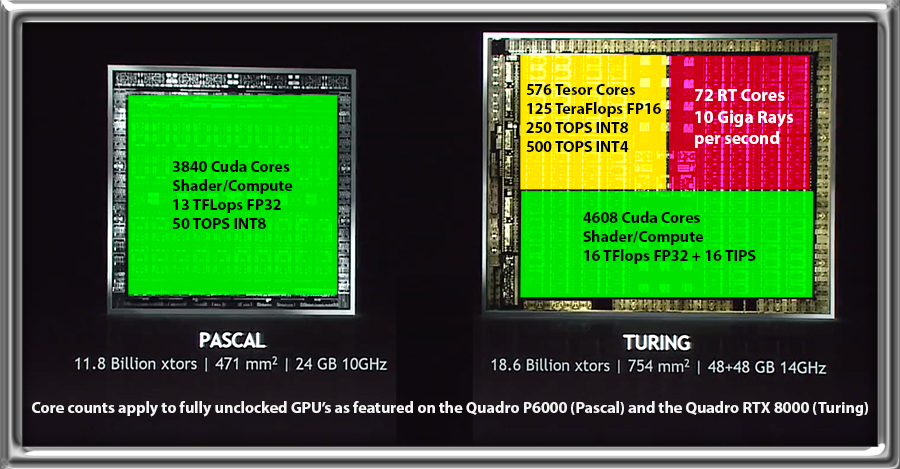
But what is this Ray-tracing of which you speak? Wailed a chorus ranging from wild ecstasy to jaded cynicism. A comprehensive explanation would be grotesquely scientific and might well take the rest of your life, so let us attempt to clarify by relating something organic and familiar. As you glance at around your man, woman or “person” cave, you will note a multitude of subtle illuminations. Behold those soft grey halos framing the frames of pictures, or gradating shadows scattered across work surfaces forming unique distortions of their origins. Observe that chrome plated kettle and the con vexed reflection of its neighbouring coffeepot. See the glittering sheen adorning your whisky tumbler, white sparkle above, rich topaz below and ignited splendidly by that ornate antique desk lamp, by far the oldest and least eco-conscious tool at your disposal but utterly indispensable thanks to your father insisting that it and drove away evil spirits.
Multi-bounce recursive Ray Tracing, as pioneered by computer scientist John Turner Whitted in 1979, is a sophisticated rendering technique employed to simulate this myriad of subtle nuances by inversely “tracing” all light assimilated by the eye of the beholder back to its origin and thus by default, eliminate superfluous rays generated by the source which the subject would never perceive. Though perfectly logical, this procedure is so rigorous that in 1979, on an industrial grade million dollar super-computer, it would have taken almost 40 hours to render a single frame of animation at the resolution high-end gamers had adopted 40 years later. And even then, that is now, those aspiring fantasists were not graced with the sublime authenticity that ray-tracing could have afforded them, for if carried out by conventional cuda cores common to Pascal and its forerunners, the process would have incurred a prohibitive speed penalty, so we were informed.
Until Turing’s historic unveiling, the prevalent method of emulating complex arrays of lighting and shadows was known as rasterization, which required artistic designers to falsify light sources within a given scene, manually specify each point of reflection and then utilise intricate pixel shading algorithms to outwardly render every path in which reflected light was projected from those locations onward. It was deemed cumbersome, inauthentic and for settings comprising a multitude of reflective points, extremely slow. So how did The Turing transform matters? To paraphrase a clunky cliche, hard decisions call for “hard-core” solutions and when a computational task of fiendish complexity arises, the most effective weapon is one customised for precisely that task. In the case of the Turing, it was RT Cores. A brigade of 72 scintillating nano-magi dedicated to conjuring, coordinating and casting 10 giga-rays of spellbinding luminosity. It was they that would, supposedly for the first time in history, allow artificial incandescence to be manipulated and showcased in real time, owing to a tenfold boost in efficiency over their willing but ill-equipped bedfellows.
Was there any reaction besides boundless ecstasy at the prospect of such a quantum leap? Well, where there’s fresh optimism, there is always frigid scepticism and in the context, one couldn’t roundly condemn it . You see, a GPU harbouring 10 times the ray-tracing prowess of its predecessor might seem like an an indispensable upgrade, but, if ray tracing itself is 10 times more onerous on resources, that performance bonus would be nullified and any justification for such a taxing process would depend wholly on how much it could enhance aesthetics. And precisely how much it could or would enhance aesthetics in turn depended on, one, how quick leading programmers would adopt and implement the technology and, two, once it had been fully exploited, weather we, the public would actually perceive and be bowled over by the “jaw-dropping” improvements.
Reactions to orchestrated comparisons which materialised on social media following Turing’s decidedly papery launch party were sharply divided.
“Just buy it,” one established and wholly “impartial” high profile site proclaimed. “Revolutionary innovation never comes cheap and in terms of virtual vividness this is the largest paradigm shift since God commanded “let their be light”. Think of where you’ll be in several months when prices still haven’t shed a dime whilst all your “enlightened” friends who placed pre-orders are reaping ravishing radiance.”
“I’ll pass thanks,” uttered a dogged cynic. “Nothing there I’ve not seen, these are games, not galleries. Salivating over specular surfaces won’t get me far against my sworn enemies. When tanks and choppers chase me around a besieged metropolis, what do I do? Stop to admire the fiery reflections in puddles and windows as their deadly artillery lays me to waste?
“Aha!” Exclaimed Green fingered fanboy. “But It is precisely those details which will assist you in your endeavours, Give you the edge over those formidable foes. Picture this. Twilight has enveloped the now deserted city, you’re sneaking along a darkened ally when all at once you hear a soft footfalls echoing your own. A staunch ally seeking to revel with you in glorious victory, or remnants of a hostile resistance hell bent on revenge? Assuming the worst, at the next junction you make a sudden strafe left and there, parked on the opposite curb is an alluring 1936 Pacard swathed in a fresh cloak of glossy midnight black laced with gleaming silver trim, opulent running boards, glowing headlamps, a radiator like the gates to an emperor’s palace, the works. Aesthetics so plentiful and precise and can only be properly realised through the sorcery of Ray-tracing!
“BANG!” yelled the doubter “See? I stood for so long ogling at a car that my stalker has shot me dead, game over.
“NO!” Cried the emerald disciple “Remember your greatest weapon? It’s not the p45, or the sawn-off shotgun, or the pump action rifle, or the rocket launcher, or the death ray, or the plasma bazooka twice your size that atomises adversaries with massive blue balloons yet somehow slips neatly into your backpack alongside your stash of 100 grenades with no hint of encumbrance. In fact, it’s none of those things. Your greatest weapon is your remarkable Turing, whose RTX cores effectively gave you eyes in the back of your head, allowing you to track your assailant’s actions in flawless clarity by covertly observing their reflection in the car door. Try doing that without Ray-tracing.”
“Hmm,” mulled the sceptic. “But if the game’s AI is up to scratch wouldn’t they be able to do the same? Besides, what’s the use if my reactions are wrecked by rubbish frame rates? I’ve never been one to laud lustre over speed, how do you think I became a death-match grand master?”
“Then just switch it off and it’ll be miles faster than what you have.”
“Miles as in one third on average so I hear.” Came a chorus of disapproval” “Not quite the astronomical increase we were lead to believe from the lean green publicity machine, and for almost double the price, no thank you!”
“Come now,” argued a voice of reassurance. “What’s a modest thousand dollars for the key to your enlightenment?”
“Twelve hundred for the founders edition.”
“Pardon me, what’s a paltry twelve hundred dollars for technology that could lend your triple A titles the sheen of a cinematic blockbuster? See those street lamps shine, those broad swords gleam. Regard the dappled shades caressing the cobbles beneath your feet in exquisite harmony with the halos adorning their surrounding elevations. Behold that towering windmill and how its weathered sails waltz with solar splendour, weaving vibrant tapestries over the fields of gold it guards.
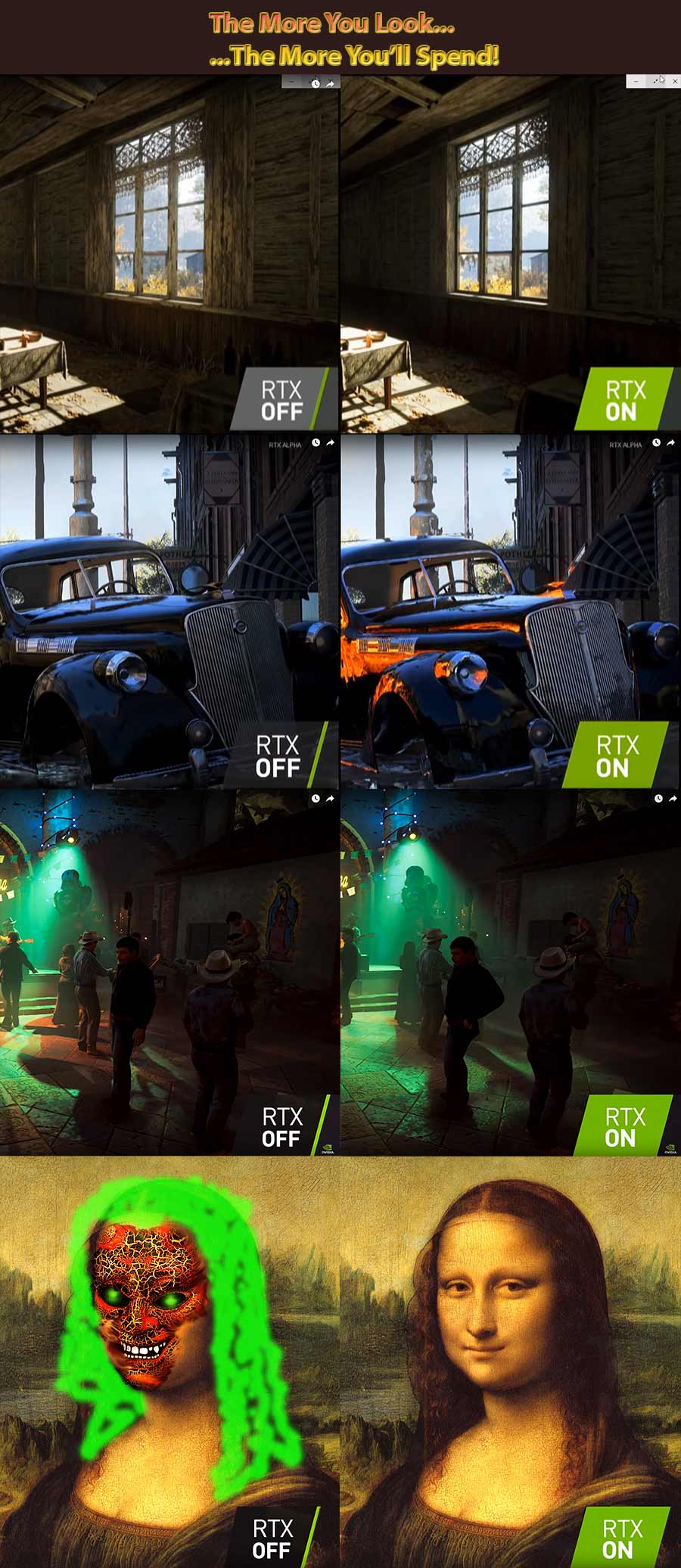
“HA! If only those comparisons lent credence to your effusive verbosity. They might as well be spot the difference puzzles.”
Of course, many outwardly negative “polyganists” were suppressing savage envy from within. The mere thought that influential rivals might publish a popular review before they’d had the chance to upload a video entitled “Why I changed my mind and bought a Turing”, drove them madder than a Cyber-Deamon on silent vegan retreat.
Nonetheless, despite this radical GPU’s glowing credentials, it was impossible to disregard the green eyes monster’s methodically brutal profiteering. Hitherto, his “hyper flagship” Titan had been the only package not aimed squarely at “professionals” to bare a bounty exceeding a thousand dollars. Now, every “amateur enthusiast” looking to attain or sustain peak performance was obliged to pay almost double the price they’d anticipated whilst those apt to settle for second best were forced to raise funds that would previously have secured them second to none. Worse yet, Nvidia’s home grown “founder’s” incarnations of the Turing were, as with Pascal, made available exclusively via their website throughout the critical period that it took for e-tailers to receive shipments from the green Goliath’s staunch board partners such as Asus, Gigabyte and MSI, all of whom were afforded margins thinner than filo pastry.
So, aside from a facility that detractors viewed as too nascent to necessitate an upgrade, what else was there to tempt affluent “techno-files” into a placing pre-order? First, we had NVlink, formerly exclusive to Quadro and Tesla cards and physically present but not on the aforementioned Titan V. This allowed for direct inter GPU communication, bypassing the comparatively meagre dimensions of the host system’s PCI express bus.
Previously, the function provided no recreational advantage and was availed solely by the horribly wealthy for “mission critical deep learning” activities such as revolutionary AI development, ground-breaking medical research or more likely, stuffing virtual vaults full of bit coins and bragging about it until the next crypto-crash. The Turing was the first to unlock NVlink’s colossal potential to “ordinary consumers” by utilising it to supplant traditional SLI, raising the available bandwidth from 2 to 100 gigabytes per second and thus, evoke a quantum leap in pixel capacity, paving the way for gaming resolutions of up to and exceeding 8K.
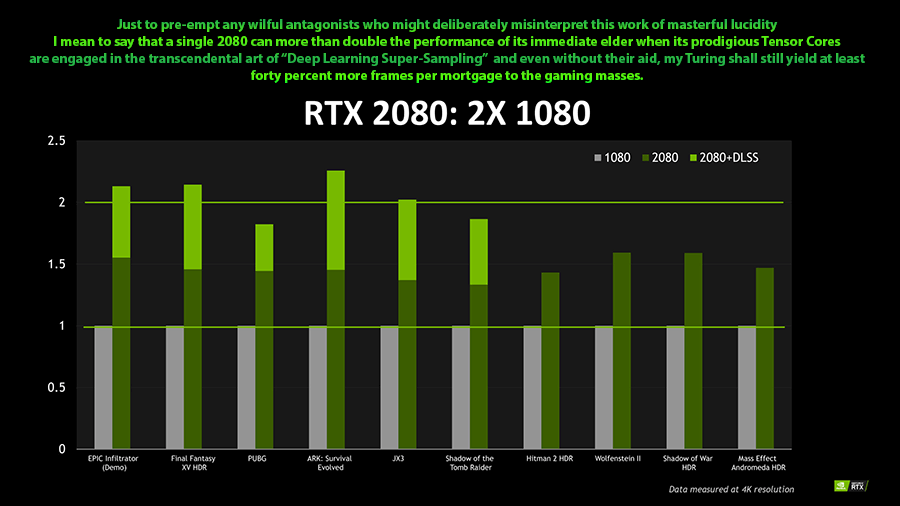
Lastly, there was Deep Learning Super-Sampling which, the most intuitive form of anti-aliasing to date which, it was claimed, harnessed the Turing’s tensor cores to intelligently apply edge-smoothing at 1080p before up-scaling the images to 4k, thereby maximizing efficiency at a negligible cost to quality. Naturally, all three of Turing’s delectable “unique selling points” presumed that third party coders and Nvidia’s driver team would maintain a constructive working relationship and consequently, that there would be enough high pedigree titles to showcase their benefits.
Those who had faith and finances were charmed from the moment that Nvidia began publicising statistical propaganda such as the cannily crafted effort above. Those who baulked at the price, Nvidia’s questionable politics or the prospect of deconstructing a three thousand dollar custom water-cooling loop for the third time in a year just to fit a new video card, were content to hold-off until independent reviewers had confirmed or debunked Turing’s supremacy. In any case, doesn’t new technology become cheaper if one waits long enough? Unfortunately not. Within the realm of emerald Elysian, “new technology” becomes cheaper if one waits for it to become “old technology” and even then…it’s only cheaper compared to the new new technology.
Once again, this jaded author was not one of those fortunate enough to be blessed with review samples or who’d coughed up on the expectation that supply would fulfill demand, only to discover they’d be receiving their pride and joy at least a week late, because it hadn’t!
Consequently, the results presented below were garnered from a host accredited sources, all of which concluded that the RTX 2080 and 2080 ti yielded performance gains of between 30% and 40% over their respective elders, though it is important to note that no game tested was recent enough to support either of Turing’s party pieces, which Nvidia claimed would be proudly showcased in 21 forthcoming titles, with a whole host to follow.
Sticklers for detail might also note that statistics, though radiant and colourful, are somewhat scant compared to former charts you may have scrutinised. We see the figures, but why no percentages? Whatever happened to minimum frame rates? Permit me to justify In the first instance, I’ve already disclosed Turing’s universal gains over Pascal and as to the second, the convention of calculating minimum frame rates had long been disregarded in favour of a more reliable formula known as “percentile”, which by contrast, could accurately identify both the presence and severity of micro-stutter and was not solely governed by a isolated clusters of “choppy” frames which might well have occurred during load screens or scene transitions and thus, precipitate misleading data. It worked by monitoring the frame rate throughout any given benchmark or time-demo and measuring the speed at which individual images were displayed against the total number of those recorded, thereby allowing the user to determine precise portions of frames whose rates fell below or above a specific threshold and how sharply performance declined as the percentage increases.
The reason for my omission it is that not every source I relied upon elected to include this information themselves and those that did chose differing “percentiles” to generate their results. Moreover, the vexing issue of micro-stutter is routinely exclusive to multi-GPU configurations and at the time of writing, no nefarious “influencer” had squandered their ill-gotten patronage on a supplementary card.





